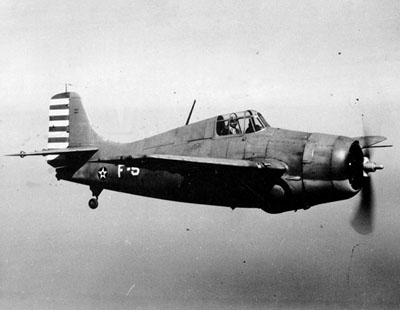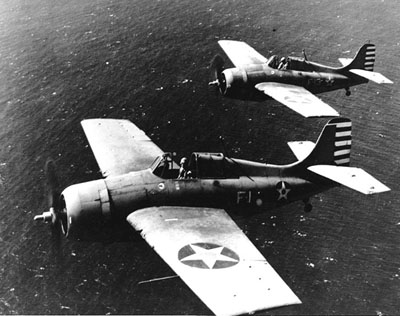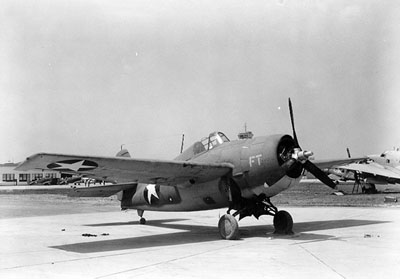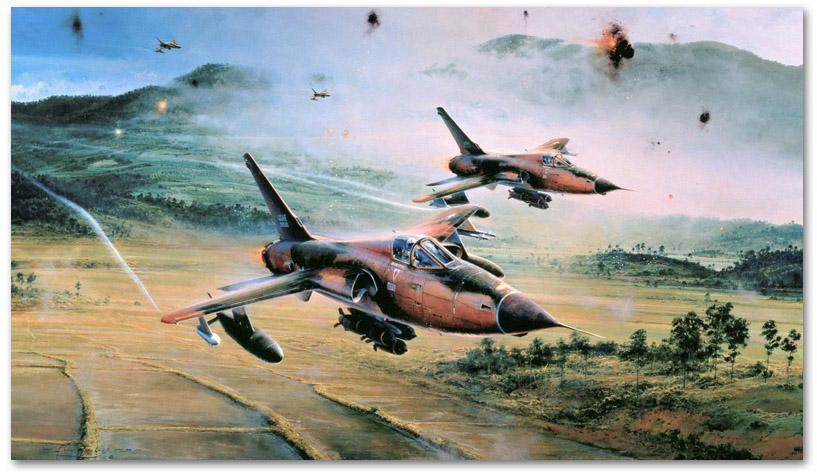|
Posted on 10/22/2003 12:00:41 AM PDT by SAMWolf
|
|
 are acknowledged, affirmed and commemorated.
|

| Our Mission: The FReeper Foxhole is dedicated to Veterans of our Nation's military forces and to others who are affected in their relationships with Veterans.
Where the Freeper Foxhole introduces a different veteran each Wednesday. The "ordinary" Soldier, Sailor, Airman or Marine who participated in the events in our Country's history. We hope to present events as seen through their eyes. To give you a glimpse into the life of those who sacrificed for all of us - Our Veterans.
|
|
First U.S. Navy Ace, Medal of Honor Recipient Savior of USS Lexington, First Hellcat Night-Fighter Edward H. O'Hare was born on March 13, 1914 in St. Louis, the son of "E.J." O'Hare, a wealthy businessman and attorney. His parents sent him to Western Military Academy (WMA) at age 13, where he pursued an interest in marksmanship, becoming president of the rifle club. In 1932, he graduated from WMA, and in 1933 went on to the US Naval Academy. Many of his classmates from both schools died in WWII. Upon his graduation from Annapolis he received choice duty on the USS New Mexico (BB-40). While he was interested in aviation, all new officers had to spend two years in surface ships, before specializing in aviation or submarines. Thus in 1939 he started flight training at Naval Air Station (NAS) Pensacola, learning the basics on N3N-1 and Stearman NS-1 biplane trainers.  Lt. Cdr. Edward "Butch" O'Hare In November, his father was gunned down by Al Capone's gunmen, most likely because he had given the government information useful in its prosecution of Capone. The gangland-style murder made big headlines, and the newspapers printed numerous speculations on the circumstances of the murder. Many of these were less than flattering and implied that E.J. was involved with the mob. (Ewing & Lundstrom's excellent biography, Fateful Rendezvous: The Life of Butch O'Hare, covers these events in great detail.) Returning to Pensacola after the funeral, young O'Hare moved up to flying more advanced biplanes like the Vought O3U, the Corsair SU, and the Vought SBU-1 scout bomber (top speed 205 mph). In early 1940, he completed the required flying in patrol planes and advanced land planes. When he finished his naval aviation training in May, he was assigned to VF-3, the USS Saratoga's Fighting Squadron. The CO was Warren Harvey; the great John "Jimmy" Thach was XO at this time, later succeeding Harvey as CO. VF-3 was flying the Grumman F3F-1 biplane and the newer Brewster F2A-1. In July, 1940, Ed O'Hare made his first carrier landing, "just about the most exciting thing a pilot can do in peacetime." Jimmy Thach used to knock the new pilots down a notch by outflying them. He would let a rookie gain an altitude advantage, and then, while reading a newspaper or eating an apple, he would out-maneuver him and get on his tail. But when he tried this on O'Hare, he couldn't gain an advantage. Duly impressed with O'Hare's impressive flying abilities, Thach closely mentored the promising young pilot.  In early 1941, VF-3 transferred to Enterprise, while Saratoga underwent a major refit at Bremerton. While the 'Big E' was at San Diego, Warner Brothers filmed the early Technicolor movie Dive Bomber on it, featuring Errol Flynn, Ralph Bellamy, and Fred MacMurray. July was an important time for Ed O'Hare. He met his future wife, Rita (proposing to her the first time he met her) and also made his first flight in a Wildcat. He and Rita married six weeks later, and for a honeymoon, they sailed to Hawaii in separate ships, Butch on Enterprise and Rita in a passenger liner. On February 20, 1942, Butch O'Hare demonstrated in real life, and when it counted most, the fighting skills he had mastered. The carrier Lexington had been assigned the dangerous task of penetrating enemy-held waters north of New Ireland. From there her planes were to make a strike at Japanese shipping in the harbor at Rabaul. Unfortunately, while still 400 miles from Rabaul, the Lexington was discovered by a giant four-engine Kawanishi flying boat. Lieutenant Commander John Thach, skipper of the Lexington's Wildcat fighters, shot down the Japanese "Snooper," but not before it had radioed the carrier's position. That afternoon Commander Thach led six Wildcats into the air to intercept nine twin-engine enemy bombers. In a determined attack each of the Wildcats destroyed a bomber and damaged two more. The ship's anti-aircraft guns finished off the rest. In the meantime, nine more Japanese bombers were reported on the way. Six Wildcats, one of them piloted by Butch O'Hare, roared off the Lexington's deck to stop them. O'Hare and his wingman spotted the V formation of bombers first and dived to try to head them off. The other F4F pilots were too far away to reach most of the enemy planes before they released their bombs. As if this weren't bad enough, O'Hare's wingman discovered his guns were jammed. He was forced to turn away. Butch O'Hare stood alone between the Lexington and the bombers.  Lieutenant Edward H. ("Butch") O'Hare, USN, (left) and Lieutenant Commander John S. Thach, USN. Shaking hands in front of a Grumman F4F "Wildcat" fighter plane at an Oahu air base, circa April-May 1942. Both men were assigned to Fighting Squadron Three (VF-3), of which Thach was Commanding Officer. O'Hare didn't hesitate. Full throttle, he roared into the enemy formation. While tracers from the concentrated fire of the nine bombers streaked around him, he took careful aim at the starboard engine of the last plane in the V and squeezed his trigger. Slugs from the Wildcats six .50-caliber guns ripped into the Japanese bomber's wing and the engine literally jumped out of its mountings. The bomber spun crazily toward the sea as O'Hare's guns tore up another enemy plane. Then he ducked to the other side of the formation and smashed the port engine of the last Japanese plane there. One by one he attacked the oncoming bombers until five had been downed. Commander Thach later reported that at one point he saw three of the bombers falling in flames at the same time. By now Thach and the other pilots had joined the fight. This was lucky because O'Hare was out of ammunition. The Wildcats took care of several more bombers and Lexington managed to evade the few bombs that were released. It was an amazing example of daring and shooting skill. Afterward Thach figured out that Butch O'Hare had used only sixty rounds of ammunition for each plane he destroyed. He had probably saved his ship. He was promoted to Lieutenant Commander and awarded the highest decoration of his country, the Congressional Medal of Honor.  With his Medal of Honor presentation, bond tours, and other commitments, Butch was out of combat from early 1942 until late 1943. On October 10, 1943, he flew with VF-6 in the air strikes against Wake Island. On this mission Alex Vraciu, the future ace, was Butch's section leader. Both O'Hare and Vraciu scored that day. In November, 1943, the Americans landed in the Gilberts (Tarawa and Makin), and the carriers were covering the landings. Equipped with the new F6F Hellcats, the US fighter pilots owned the skies, and could protect the Navy's warships from Japanese aircraft. From their bases in the Marianas, the Japanese quickly developed tactics to send torpedo-armed Bettys on night missions against the US carriers. In late November they launched these low-altitude strikes almost nightly, in a deadly attempt to get at Enterprise and other American ships. Ed O'Hare, now Enterprise Commander - Air Group (CAG), was deeply involved in developing ad hoc counter-tactics, the first carrier-based night fighter operations of the US Navy. As the primitive radars were very bulky, they were carried on the Enterprise, on the fairly large TBF Avengers, but not on the smaller and faster Hellcats. The plan required the ship's Fighter Director Officer (FDO) to spot the incoming Bettys at a distance and send the Avengers and Hellcats toward them. The radar-equipped Avengers would then lead the Hellcats into position behind the incoming Bettys, close enough for the Hellcat pilots to spot visually the Bettys blue exhaust flames. Finally, the Hellcats would close in and shoot down the torpedo-carrying bombers. All the planes on both sides would be flying at low level. The plan was experimental, complicated, risky, and necessary - if the Bettys were to be thwarted.  F6F Hellcats The night of November 27, 1943 was the first combat test of the plan, following an earlier mission that hadn't contacted the Japs. The 'Black Panthers', as the night fighters were dubbed, included two sections of three planes. Both included two Hellcats and one Avenger. Butch led his section from his F6F, Warren Skon flew on his wing; Lt. Cdr. Phillips piloted the TBF with radarman Hazen Rand and gunner Alvin Kernan crewing the plane. (Alvin Kernan's memoirs of his experiences as an enlisted man on US Navy carrier during WWII, Crossing the Line: A Bluejacket's World War II Odyssey, describe this night in detail, from the perspective of the man who fired the Avenger's gun seconds before Butch disappeared. (The book also happens to be the best-written narrative of WWII naval aviation that I've read in a long time. I recommend it highly. But it's now out-of-print.) The night's events were complicated and confusing: the Hellcats had trouble finding the Avenger, the FDO had difficulty putting any of them on the targets, and it was all new to everyone. Phillips, in his lightly armed Avenger, found some of the attacking Japanese bombers and surprisingly, shot two of them down. Following that brief action, in the dark, with nothing to be seen but the flaming gasoline from the downed Bettys burning on the water (for over an hour?), the O'Hare and Skon got into position behind the Avenger. About that time, the Avenger identified a Betty behind the Hellcats. Kernan fired at it. Moments later, O'Hare failed to respond to the radio; he had gone down.  TBF Avenger What happened? There are three possible explanations:
For their roles in protecting the carrier and in carrying out the Navy's first combat night-fighting mission, Phillips, Rand, and Kernan were awarded Navy Crosses. (Cynics ever since have concluded that the Navy, having to choose between courts-martial or medals for the Avenger crew, opted for the latter, not wanting to admit that its biggest hero had been brought down by friendly fire.) Having read Lundstrom's book, Fateful Rendezvous: The Life of Edward O'Hare, and Kernan's memoirs, Crossing the Line: A Bluejacket's World War II Odyssey, I'm inclined to accept Lundstrom's most likely explanation, and also his general conclusion. Both books are very well-written , and I recommend them to readers interested in this topic, not merely for the events of November 27, 1943.
|
LOL. Not if I can help it!
But Butch O'Hare was Easy Eddie's son.
Today's FReeper Foxhole has been both an excellent read (as usual) and a blessing. Another precious example of a father's love . . .

|
Air Power |
In 1936 the US Navy evaluated a number of designs which were competing to be the Navy's new carrier-based fighter. Grumman built a design which, after several re-designations and airframe modifications, won the contract and eventually became the F4F Wildcat. The prototype, the XF4F-2, first flew on 2 September 1937. The prototype of an improved version, the XF4F-3, was renamed the F4F and was ordered by the Navy in August of 1939. The first five aircraft off the assembly line were sent to Canada, with the next 90 (designated "Martlet Mk I" going to the 804 Squadron of the Royal Navy's Fleet Air Arm where, in December 1940, two Martlets made history by becoming the first American-made aircraft to down a German plane in WWII.
The first US Navy F4F-3 was flown on 20 August 1940, powered by a Pratt & Whitney R-1830 engine with 1,200 horsepower. The subsequent F4F-4, incorporating several improvements including folding wings, six guns and self-sealing fuel tanks, was delivered in November 1941. It was then that the name "Wildcat" was first given to the F4F. As war raged around the world, the Wildcat's reputation and utilization grew immensely. It flew with the US Navy and US Marines in all of the major Pacific battles, and in North Africa with the Navy.
In mid 1942, Grumman realized that it needed to concentrate on the production of its new F6F Hellcat fighter, and so it contracted with the General Motors Company to build the Wildcat under the designation FM-1. The first FM-1 flew on 31 August 1942, and over 1,150 of them were produced, hundreds of which went to the Fleet Air Arm as the "Martlet Mk V." General Motors next developed an improved version, called the FM-2 ("Wildcat Mk VI" in the Fleet Air Arm), which was powered by a Wright R-1820 engine with 1,350 horsepower. It featured a taller vertical tail than the FM-1. Over 4,700 FM-2s were built before the Wildcat was eclipsed by the more capable fighters which appeared later in the war.
Specifications:
Primary Function: Naval Fighter
Contractor: Grumman
Crew: One
Unit Cost: N/A
Powerplant: One 1,200 horsepower Pratt & Whitney R-1830-86 double-row radial engine
Dimensions:
Length: 28 ft 9 in (8.76 m)
Wingspan: 38 ft 0 in (11.58 m)
Height: 9 ft 2.5 in (2.81 m)
Weights: - Empty: 5,758 lbs (2,612 kg) - Maximum Takeoff: 7,952 lbs (3,607 kg)
Performance:
Speed: 320 mph (512 km/h) at 19,800 ft & weight of 7975 pounds
Ceiling: 39,400 ft (12,010 m)
Range: 770 miles (1,239 km)
Armaments:
Six .50 caliber Browning machine guns;
Two 100-pound bombs




All photos Copyright of Global Aircraft.Com
That's part of our insideous plot. Get people to want to know more. :-)
You mean I've fallen for our own plot? Egads.
LOL.
LOL! Great foresight by some of America's largest Corporations.

Wellllll.... Ummmmmmmm.... Supposed to be......
Disclaimer: Opinions posted on Free Republic are those of the individual posters and do not necessarily represent the opinion of Free Republic or its management. All materials posted herein are protected by copyright law and the exemption for fair use of copyrighted works.